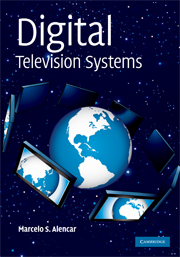Book contents
- Frontmatter
- Contents
- List of figures
- List of tables
- List of contributors
- Preface
- Acknowledgments
- 1 Fundamentals of digital television
- 2 Audio and video coding
- 3 Fundamentals and standards of video and audio compression
- 4 Channel coding for digital television
- 5 Digital and analog transmission systems
- 6 Advanced Television Systems Committee standard (ATSC)
- 7 Digital video broadcasting (DVB)
- 8 International Services Digital Broadcasting for Terrestrial Television Broadcasting (ISDB)
- 9 International System for Digital Television (ISDTV)
- 10 Digital terrestrial television multimedia broadcasting (DTMB)
- Appendix A Evolution of television standards
- Appendix B Signal analysis
- Appendix C Random signals and noise
- Glossary
- References
- Index
Appendix A - Evolution of television standards
Published online by Cambridge University Press: 28 January 2010
- Frontmatter
- Contents
- List of figures
- List of tables
- List of contributors
- Preface
- Acknowledgments
- 1 Fundamentals of digital television
- 2 Audio and video coding
- 3 Fundamentals and standards of video and audio compression
- 4 Channel coding for digital television
- 5 Digital and analog transmission systems
- 6 Advanced Television Systems Committee standard (ATSC)
- 7 Digital video broadcasting (DVB)
- 8 International Services Digital Broadcasting for Terrestrial Television Broadcasting (ISDB)
- 9 International System for Digital Television (ISDTV)
- 10 Digital terrestrial television multimedia broadcasting (DTMB)
- Appendix A Evolution of television standards
- Appendix B Signal analysis
- Appendix C Random signals and noise
- Glossary
- References
- Index
Summary
The beginning of image broadcasting
The history of television owes a lot to engineers, mathematicians, and physicists, who have introduced an important vehicle for information transmission to civilization. Since the beginning of the nineteenth century, scientists have been investigating long-distance transmission of images, and it was with Alexander Bain's invention, in 1892, that the telegraphic transmission of an image (facsimile) was obtained.
In 1817, the Swedish chemist Jacob Berzelius discovered selenium, but it was not until 56 years later, in 1873, that the Englishman Willoughby Smith proved that this substance possessed the property of turning light into electricity. This property was used by Father Roberto Landell de Moura in his inventions (Alencar et al., 2004).
Julius Elster and Hanz Geitel invented the photoelectric cell in 1892. In Russia, Boris Rosing made similar discoveries. The system made use of moving mirrors in addition to the cathode ray tube.
In 1920, broadcasts were made with the help of John Logie Baird, from the United Kingdom, who used a mechanical system based on Paul Nipkow's invention. Nipkow's disk consisted of a device, invented in 1884 by Nipkow, that sent moving images using an electric conductor. To accomplish this, he used selenium's property to vary electrical conductivity proportionately to the intensity of light.
In 1924, Baird made the first distance broadcasts of object outlines, and, in the following year, of people's faces. In 1926, Baird gave the first demonstration to the scientific community at the Royal Institution in London, and then signed a contract with the BBC for experimental broadcasts.
- Type
- Chapter
- Information
- Digital Television Systems , pp. 213 - 218Publisher: Cambridge University PressPrint publication year: 2009



